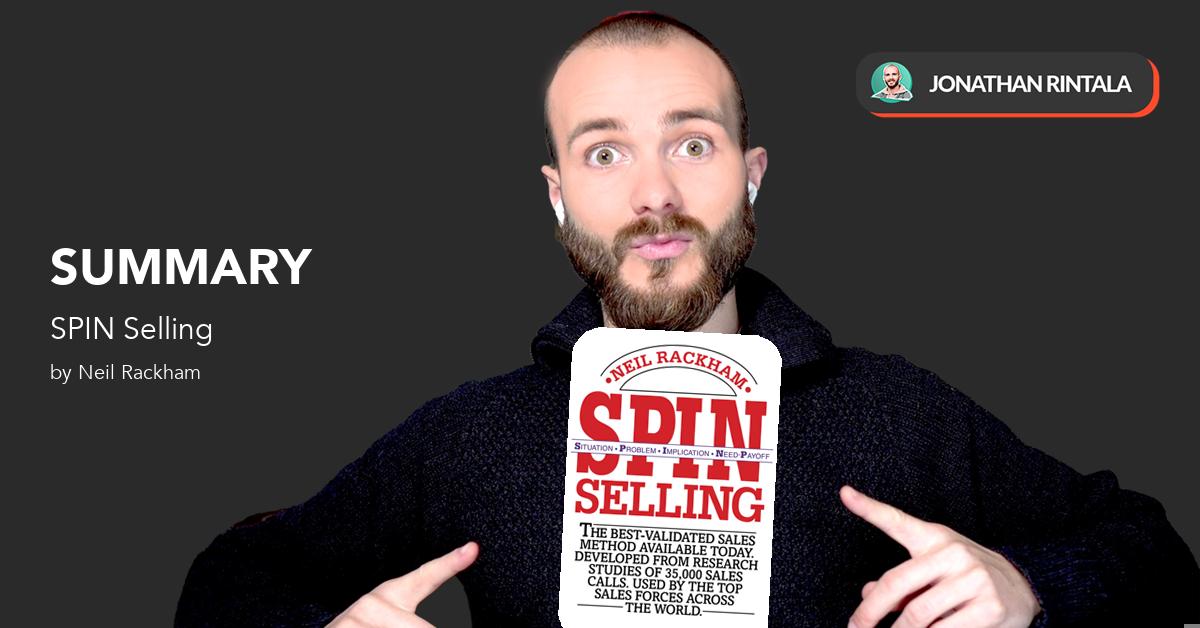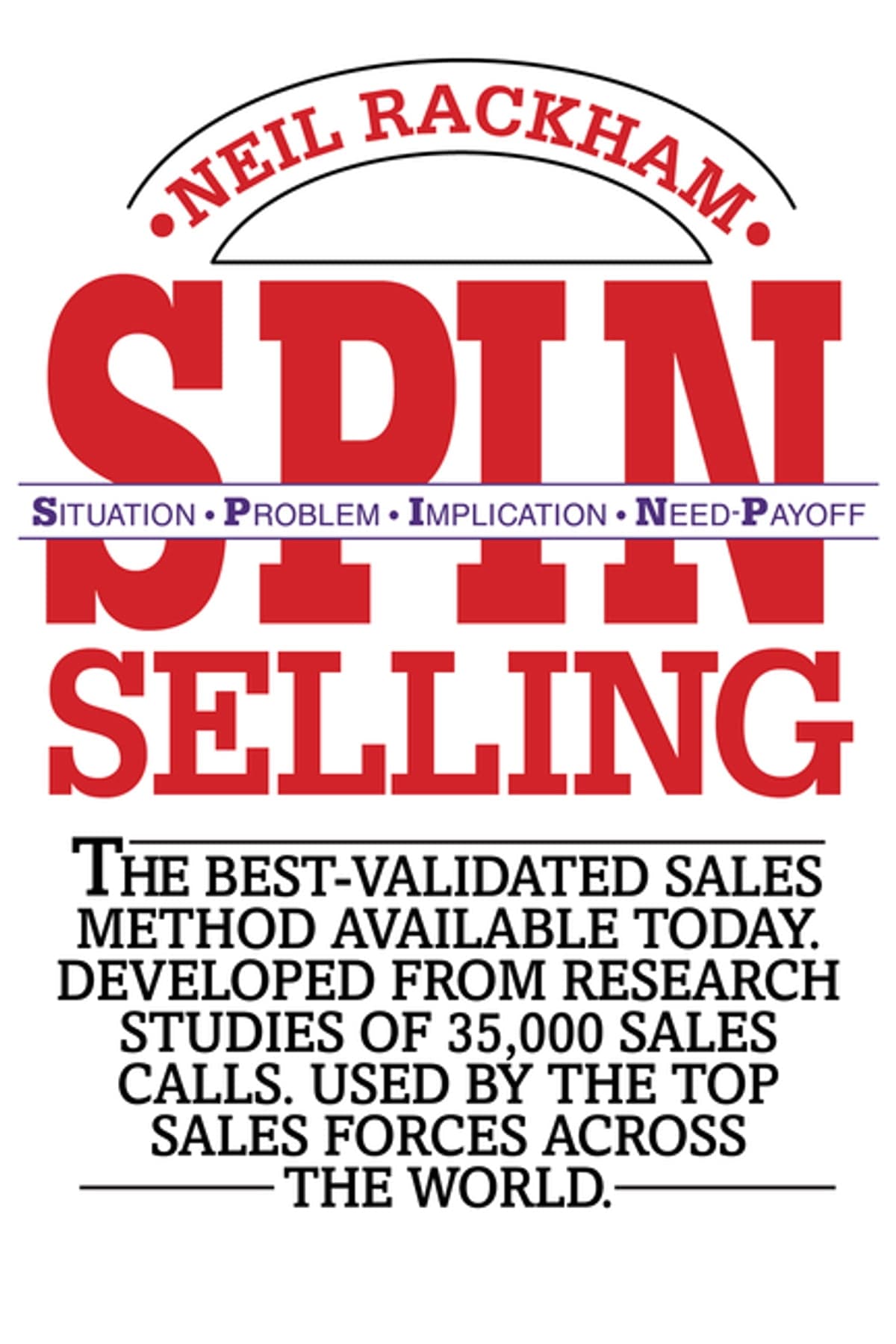SPIN Selling - Summary and review

🚀 Summary: SPIN Selling in 30 seconds

Contents
SPIN Selling was written back in 1988, but is still relevant today, as it breaks down 35,000 sales calls and 12 years of research - combined into the SPIN sales strategy.
1. Asking the right questions to close complex deals - the four SPIN types of questions
High performers in major sales ask a lot of need-payoff questions - addressing needs, helping the buyer to self-diagnosing their problems, and seeing the benefits of buying now rather than later.
There are 4 types of questions that one can ask:
Question type 1: Situation
These questions help reps find out about the status quo.
Why use: Understand business goals, processes, and environmental factors surrounding the prospect.
Examples: What tools do you currently use? Why did you invest in these tools? Why is this priority important to your business?
Question type 2: Problem
These questions help reps uncover the problem of the buyer.
Why use: Reveal opportunities - these might be stated explicitly, or inferred.
Examples: Why does this approach work/not work for you? What is your biggest day-to-day challenge? What’s stopping you from solving it?
Question type 3: Implication
These questions drive urgency around solving a problem.
Why use: Show buyers why they need to change.
Examples: Has the business ever missed a KPI due to your current approach? How much does your current approach cost? How is {problem} impacting your work?
Question type 4: Need-payoff
These questions guide buyers to see 1. the benefits of solving the problem, and 2. the payoff for taking action now rather than later.
Why use: Move the buyer towards a specific next step.
Examples: What would change if you did {approach} differently? Would your team get value from {solution}? How do you think solving {problem} would help you? What would achieving {priority} unlock for your business?
2. A four-step sales process
Step 1: Opening
Use this opening phase to build trust. Have some casual conversation. You could ask “how’s the weather?” or “any fun weekend plans?”. Pace yourself here, give room for breathing, and be careful not to be too pushy here.
Think about: Why should the prospect trust 1. you, 2. the company you work for, and 3. your product.
Step 2: Investigating
Go deeper and understand the challenges and opportunities of their business. Avoid jumping to conclusions - guide the buyer to self-diagnose their problems and have them say it out loud themselves.
Step 3: Demonstrating capabilities
Introduce your product, and present it as a solution to the pains and needs you discovered. There are 3 ways to do this: Speaking to features, advantages, or benefits. To exemplify - let’s say you are selling a webinar platform called Univid.
Features: what your product can do.
Some features of your webinar platform could be - browser-based, interactivity via polls, reactions, Q&A, and call-to-actions
Advantages: how your product is used
Some advantages of using your webinar platform could be - not having to download any software, connecting with your audience, receiving more feedback, having people pay more attention, driving more conversions
Benefits: the outcomes you receive because of the features and realized advantages
Some benefits could be explained in the following way:
“Because your audience doesn’t have to download anything, you will enjoy a much higher attendance rate”
“Since you can work with polls and reactions that are fun to use, you can connect with your audience who will stay more focused and remember your webinar”
“You can spend much less time preparing before, and rely more on the interaction doing the work for you - getting questions via Q&A and discussing the peer-generated input you get via polls”
“Because you can activate clear call-to-action buttons, your attendance can enjoy a frictionless next step to take the conversion you aim for, and reach your desired goals of the webinar”
Step 4: Obtaining commitment
It’s time to ask for a specific next step. Depending on your sales funnel this could mean another call with additional stakeholders, a proof of concept, or actually closing the deal.
Be prepared to deal with objections here, that might surface when asking to confirm the next step with your prospect.
3. Major vs small sales - how deal size affects the approach
Making a larger buy is a bigger decision for the customer. Thus, trust is key. Here are three factors that distinguish small vs. major sales.
Size of commitment: In small sales, the deal size is smaller, and naturally the commitment from the buyer is not as big. In major sales, it is a larger transaction; thus, the perceived value must be much greater - that’s a key challenge for the sales rep.
Trust and ongoing relationship: In small sales, it is typically a one-time interaction between seller and buyer. In major sales, the buyer has to have a longer-lasting relationship with the product.
The risk of mistakes: Making the wrong purchase in a major B2B procurement could worst-case cause the buyer to lose their job. It could also be a very public mistake. Therefore, trust in the sales rep, product, and company is key.
An example of this is closing techniques, which improve the closing rate in small sales, but actually, reduce the number of closed deals in major sales.
Also, in major sales, a key skill is to be able to increase the perceived value of a product.
✍️ My top 3 quotes
These are, in my opinion, the top quotes from the book SPIN Selling.
Quote 1
Successful sellers never push the customer beyond achievable limits
Quote 2
The building of perceived value is probably the single most important selling skill in larger sales
Quote 3
In our research we consistently found that the people who were most effective during the Investigating stage were the ones most likely to be top sales performers
SPIN Selling review - what kind of book is it?
Published 34 years ago, still highly relevant. A must-read for anyone in B2B sales, or dealing with larger deal sizes. Many quantitatively based learnings from analyzing over 35,000 sales calls. This book gives you solid tools to take your sales game to the next level. Both in terms of a useful framework, but also insights and structure into the sales process and psychology of sales.
Frequently asked questions (FAQs)
Q: Who is Neil Rackham?
Neil Rackham is the former president and founder of Huthwaite. In the 1970’s Neil first gained international recognition for his studies of sales effectiveness, when he led the largest-ever research study of successful selling - laying the foundation for SPIN Selling.
Q: Why should you read SPIN Selling?
Read this book to learn more about the science of sales, improve your sales, or close more deals. Learn what top sellers are actually doing, which parts of larger sales matter and learn techniques to make improvements - not what the most hyped closing techniques look like.
Q: Who is the ideal reader of SPIN Selling?
If you are interested in the area of sales and improving your sales in a systematic way SPIN Selling is a great book for you. The book provides a great framework to work with, and also gives insights into understanding 1. the process of sales, and 2. what top sellers do.
Q: Is the SPIN Selling available as PDF?
If you (A) think the summary of SPIN Selling above is not enough, or (B) the summary makes you crave the full book - you can also find the PDF or Epub versions at Amazon, or your nearest bookstore.
Want to learn more about growing SaaS companies?

